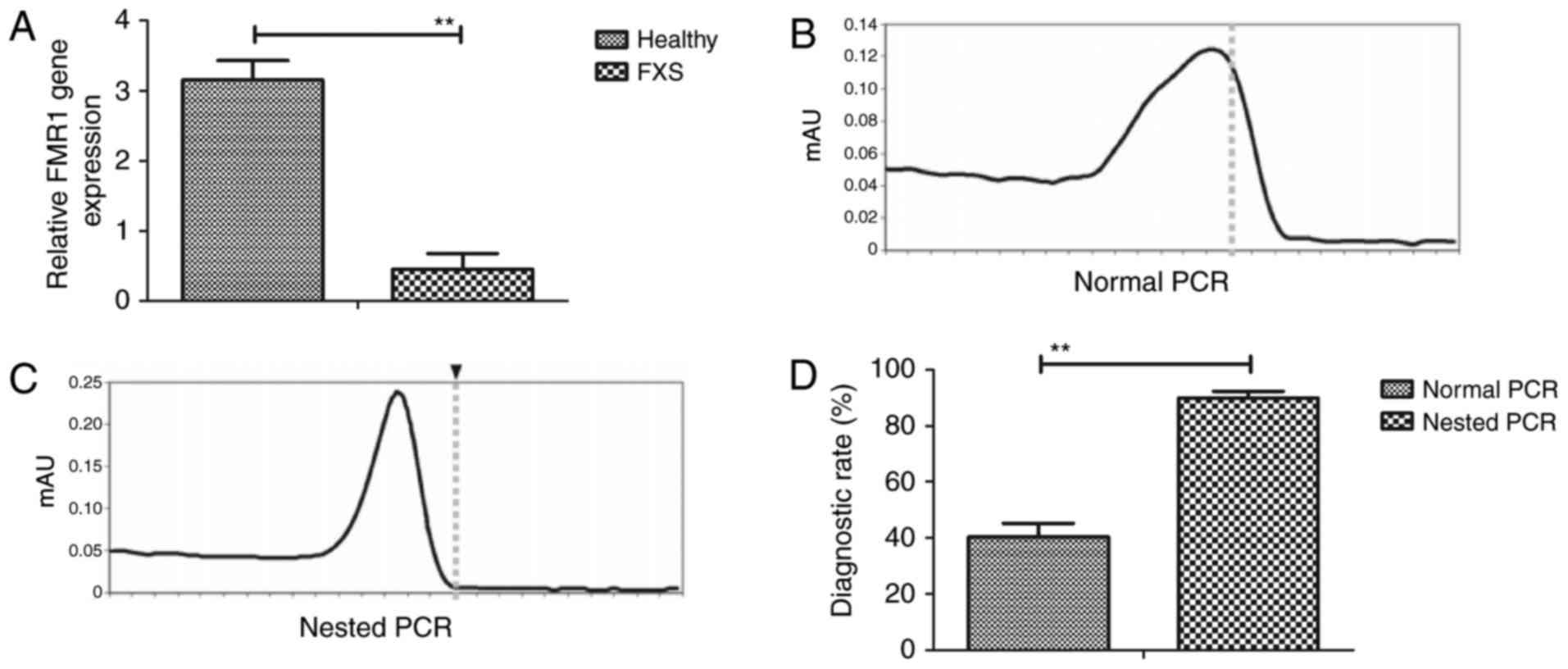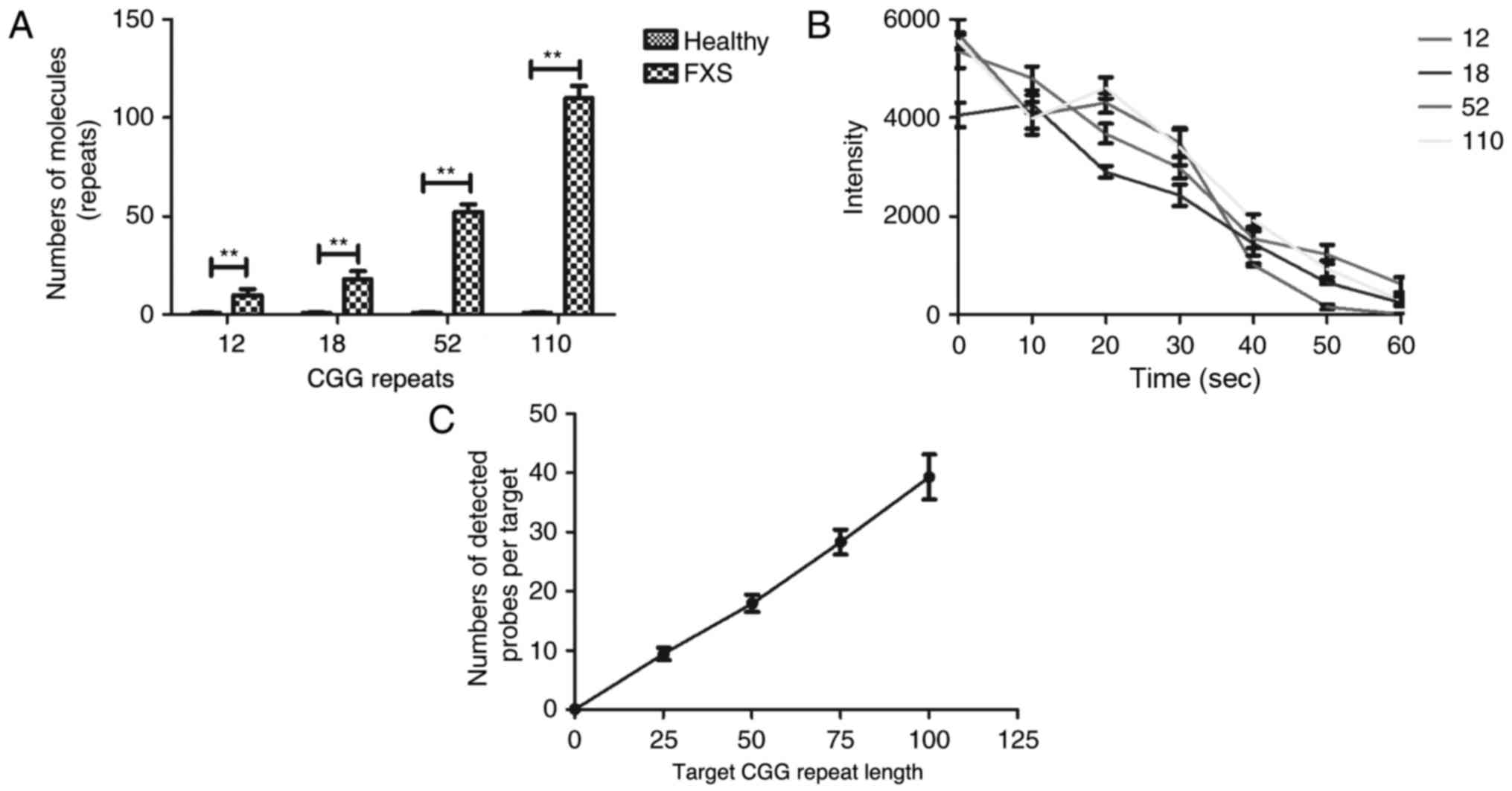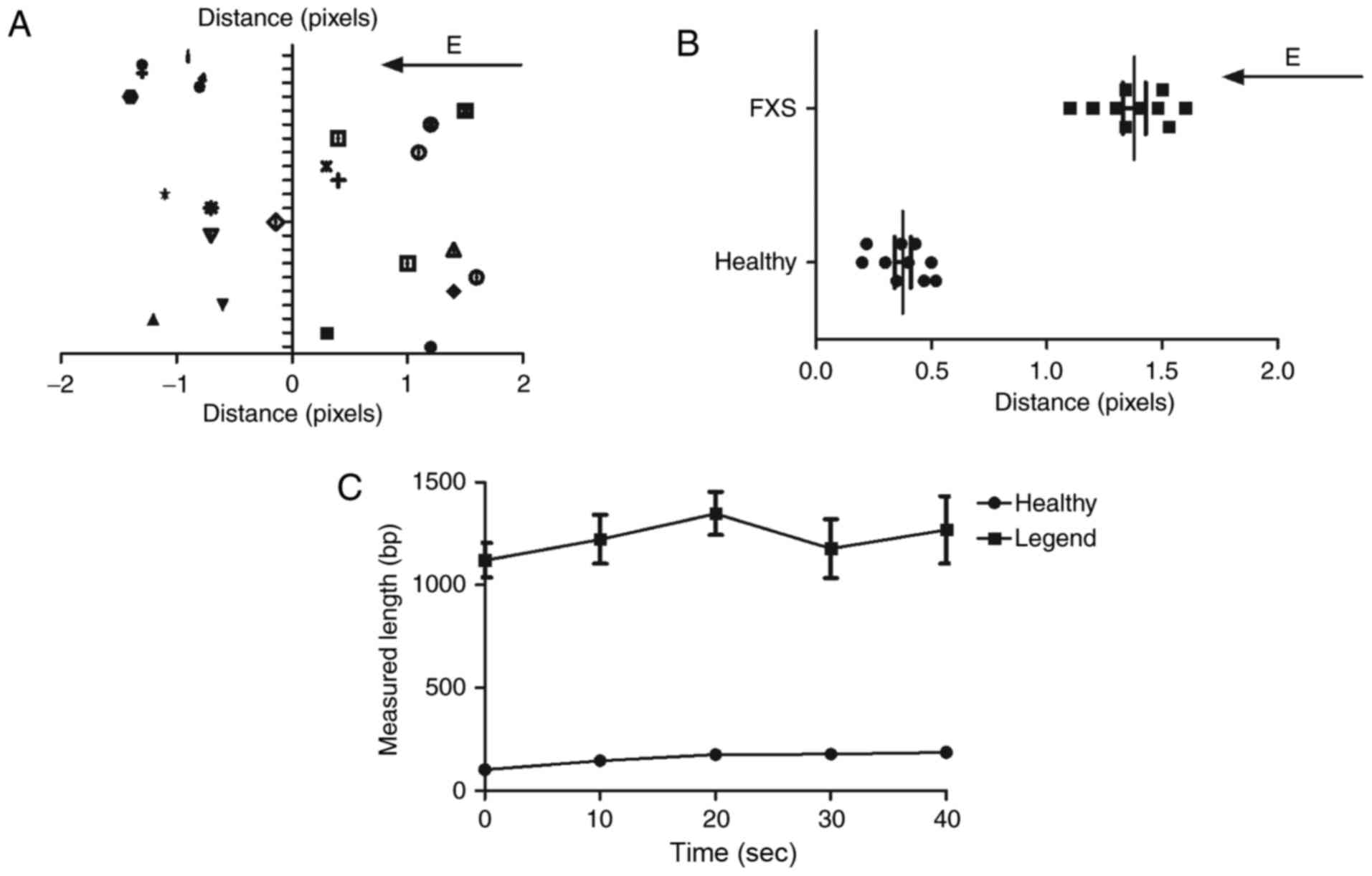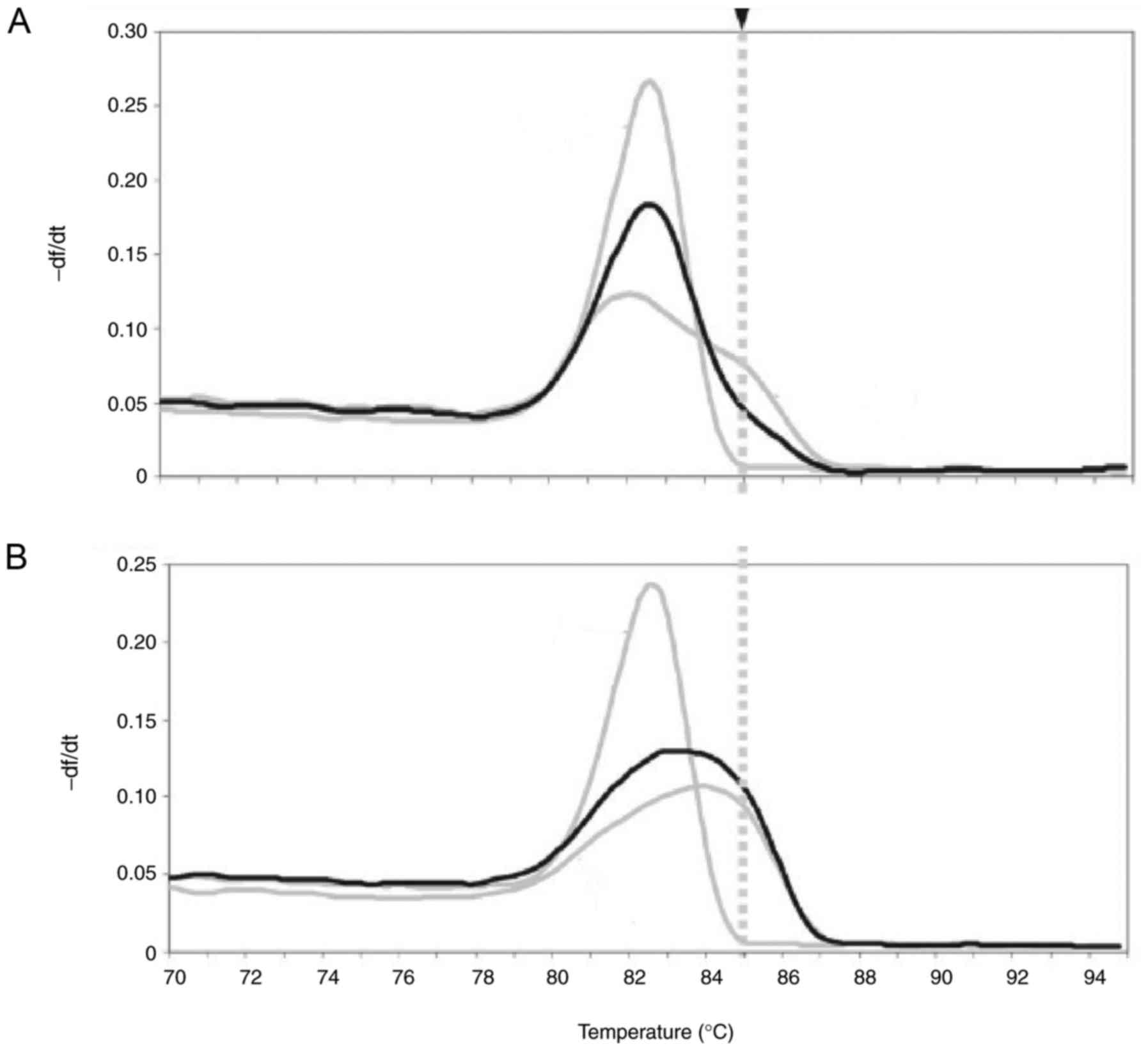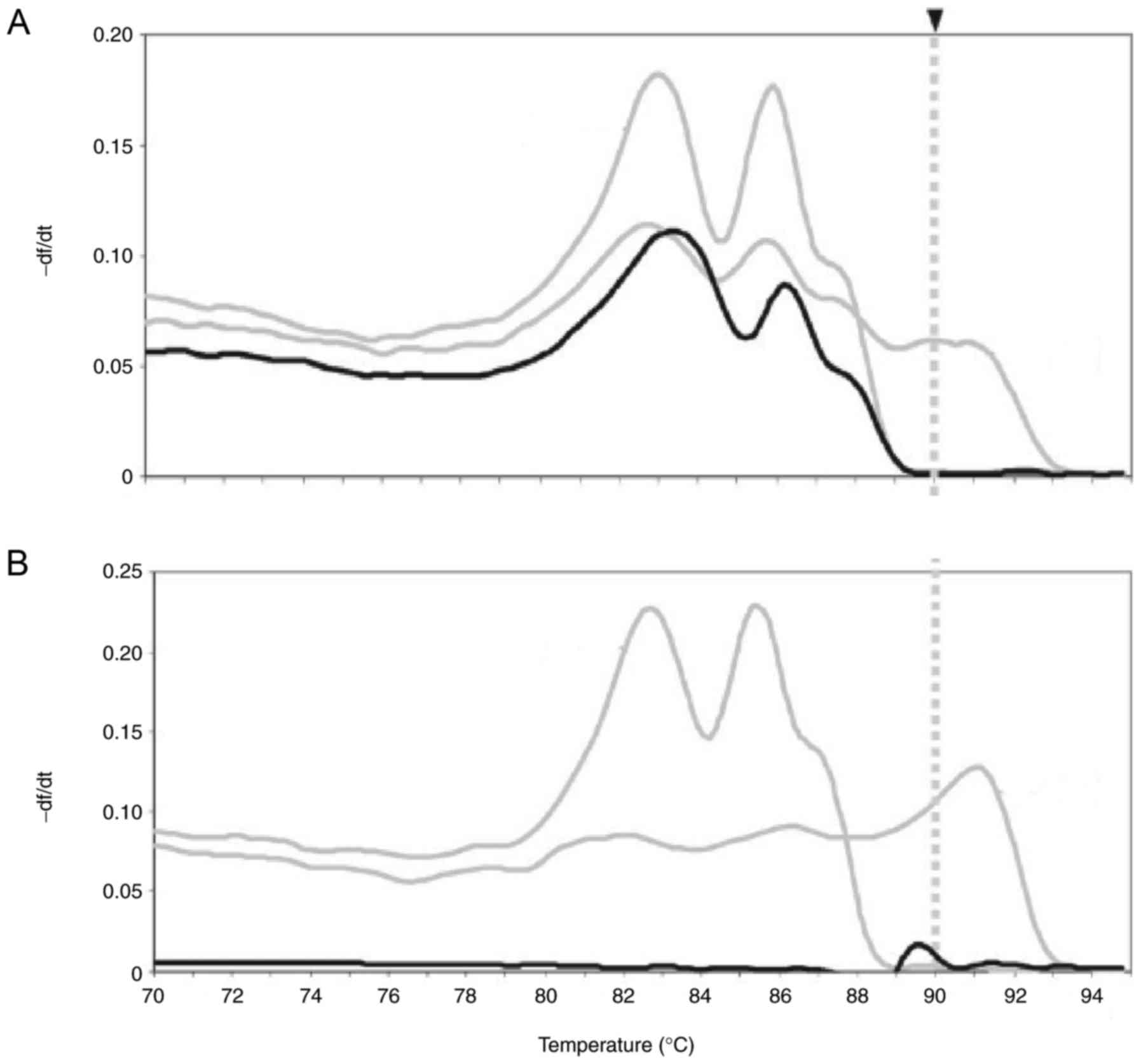Assessment of efficacy of prenatal genetic diagnosis for fragile X syndrome using nested PCR
- Authors:
- Published online on: April 13, 2018 https://doi.org/10.3892/etm.2018.6060
- Pages: 5107-5112
Abstract
Introduction
Fragile X syndrome (FXS) is one of the most common monogenic diseases that can lead to autism spectrum disorder and intellectual disability (1). Genetic diagnosis shows that FXS is an X-linked genetic disorder that is characterized by behavioral problems and specific physical dysmorphisms (2). Child patients with FXS have ritualistic behaviors and social deficits and study has provided for early recognition and diagnosis for the children patients (3). Previous study indicated that FXS included the clinical manifestations, such as language delay, intellectual dysfunction, behavioral and social problems, and other physical malformations (4). In recent years, although various medical treatments have been applied for patients with FXS, a spectrum of medical problems are commonly experienced by people with FXS, such as otitis media, seizures, and gastrointestinal problems (5). Therefore, the efficacy of prenatal genetic diagnosis for FXS plays essential role for prenatal diseases testing.
Currently, FXS is regarded as a monogenic disease caused by expansion of a trinucleotide repeat in the 5′ untranslated region of the fragile X mental retardation 1 (FMR1) gene (6). The FMR1 gene is a microsatellite locus that contains <55 CGG repeats in its 5′-untranslated region on Xq27.3 (7). Bioinformatics has indicated that CGG repeat (>200 CGG repeats) in its 5′-untranslated region is associated with fragile X tremor and ataxia syndrome (FXTAS) by silencing FMR1 gene and resulting in FXS (8,9). The abnormal CGG expansion results in methylation and transcriptional silencing of the FMR1 gene, which subsequently leads to a reduction or loss of fragile X mental retardation 1 protein (FMRP) (10). Additionally, previous study has indicated that methylation of the FMR1 gene exon 1/intron 1 boundary positioned fragile X related epigenetic element 2 (FREE2) affects X-chromosome inactivation (XCI) in FXS full mutation (11).
In recent years, antenatal diagnosis of FXS plays essential role in prevention of FXS (12–14). Study has found that single-tube polymerase chain reaction (PCR) panel of highly polymorphic markers is an efficient method for preimplantation genetic diagnosis of FXS (15). Interestingly, nested PCR presents higher specificity than traditional PCR using two sets of primers (16). However, the diagnostic sensitivity of traditional PCR is not enough for FXS patients for the reason that it can be only detect the smaller pre-mutation gene (17). Notably, nested PCR can be used to diagnose Preimplantation genetic diagnosis for FXS, which has indicated that amplification efficiency was > or =96% for the FMR1 CGG-repeat region and 5–10% for the polymorphic markers (18). Although Southern blot analysis is the gold-standard method for the molecular diagnosis of FXS, low resolution and complex technology is not suitable for mass screening for FXS patients (19).
Currently, gene detection using PCR is essential for patients with suspicious FXS, which could give a good birth and good care (20). In this study, we evaluated the diagnostic efficacy of nested PCR for patient with suspicious FXS. Our results provide a reliable method for diagnosis of the FMR1 mutation and CGG repeat lengths using nested PCR.
Materials and methods
Ethical statement
This study was performed in Jiaxing Maternity and Child Health Care Hospital (Jiaxing, China from May 2015 to December 2016. This study was carried out with approval by the Ethics Committee of Jiaxing Maternity and Child Health Care Hospital. All patients and healthy individuals provided written informed consent before their participation. The use of their blood samples were also approved with written informed consent of participators.
DNA samples
A total number of 32 female patients with FXS and 32 healthy female donors were recruited for gene expression analysis. The mean age was 28.4 (range, 23.2–36.4) and 28.8 (range, 22.6–35.8) years old in patients with FXS and healthy female donors, respectively. Genomic DNA samples from female FXS carriers and healthy female donors were analyzed in this study. Assays were performed with 32 genomic DNA samples of known FMR1 mutation (12, 18, 52, and 110 repeats) and 32 genomic DNA samples of healthy individuals. All cell line DNA templates were purchased from the Coriell Cell Repositories (Coriell Institute for Medical Research, Camden, NJ, USA) with critical diagnostic cutoffs. DNA was extracted using the EasyXpress Viral Nucleic Acid Release kit from Express Biotech International, Inc. (Thurmont, MD, USA). DNA was prepared for PCR products from with a master mix from Asuragen containing GC-rich AMP buffer, FMR1 primers, and GC-rich polymerase mix.
Nested PCR
The CGG repeat-containing ssDNAs were analyzed using Cy3-labeled [5′-Cy3-CCGCCGCCGCCGCCG-3′; (CCG)5] repeat probes and a Cy5-labeled probe (5′-Cy5-CATCTTCTCTTCAGCCCTGCTAGCGCCGGGAGC-3′; Integrated DNA Technologies, Coralville, IA, USA). The samples were heated to 95°C and then cycled 100 times above and below the Tm of the repeat probe to optimize binding in 100 mM NaCl, 25 mM Tris-Cl, pH 8.0. PCR procedures were performed as follows: Denaturation step at 94°C for 5 min; 40 cycles of denaturation at 94°C for 30 sec; annealing at 56°C for 30 sec; extension at 72°C for 45 sec, with a final extension at 72°C for 5 min; 4°C soak. For nested PCR, following the same cycling procedures defined in traditional PCR. Nested PCR was used to amplify different DNA copy number to increase the sensitivity of PCR fragment detection.
Analysis of dried blood spots
Peripheral blood (5 ml) was collected from female FXS carriers and healthy female donors using blood collection tube (Qiagen, Hilden, Germany). To examine FMR1 gene, we spiked 1.5 µg genomic DNA and spiked blood samples were settled onto 3MM Whatman filter paper and were dried for 12 h at 25°C. DNA was extracted described in DNA samples and then eluted in 200 µl of the supplied buffer. Both the normal and nested PCR assays were performed to analyze FMR1 mutation.
Capillary electrophoresis
All samples were analyzed by capillary electrophoresis described previously (21). Conditions for traditional PCR and nested PCR for subsequent capillary electrophoresis were identical to those for CCG repeat. Assays were performed by 5′ dTP-PCR reaction used 0.15 mmol/l 7-deaza-dGTP, 0.05 mmol/l of dGTP, SYBR-Green I, 5′ and 3′ flanking primers, end-labeled with 6-carboxyfluorescein and 3′ dTP-PCR primers, and thermocycling was performed on the GeneAmp PCR System 9700 (Applied Biosystems; Thermo Fisher Scientific, Inc., Waltham, MA, USA). Electropherograms were analyzed with GeneMapper software (version 4.0; Applied Biosystems; Thermo Fisher Scientific, Inc.).
DNA sequencing
PCR-amplified FMR1 productions were purified by a QIAquick PCR Purification kit (no. 28104; Qiagen). Concentration of PCR productions was calculated using NanoDrop spectrophotometer. DNA sequencing reactions were completed with 2 to 5 ng of purified PCR products using BigDye Terminator v3.1 Cycle Sequencing kits (Applied).
Statistical analysis
All data were analyzed by Statistical Package for the Social Sciences (SPSS 19.0; IBM Corp., Armonk, NY, USA). ROC curve analysis was determined by the accuracy of the temperature cutoffs, classifies samples and expansion negative in the blinded validation study. The distributions of the measured CGG repeat values were fit with two Gaussian functions to determine the average values and the relative fractions of the repeat populations.
Results
Comparison of nested PCR and PCR in diagnosis of FXS
We first compared the efficacy of nested PCR and traditional PCR in diagnosis of FXS. We showed patients with FXS showed lowed FMR1 gene expression compared to healthy individuals (Fig. 1A). As shown in Fig. 1B and C, nested PCR was different with PCR for samples, which could diagnose patients with FXS. Results demonstrated that nested PCR presented more sensitivity than PCR in diagnosing of FXS (Fig. 1D). These results show that nested PCR is a potential method for diagnosis of FXS patients.
Analysis of CGG repeat length based on nested PCR
To validate the efficacy of nested PCR, we tested DNA target strands spanning the normal and gray-zone and analyzed CGG repeat sequences. We depicted that representative nested PCR combined immobilized probe-bound targets with CGG repeat lengths of 12, 18, 52, and 110 (Fig. 2A). As shown in Fig. 2B, nested PCR combined immobilized probe-bound targets with CGG predominantly exhibited a complete loss of fluorescence in FXS patients compared to healthy individuals. As shown in Fig. 2C, target CGG repeat length is positively associated with the average number of probes bound using nested PCR. These results indicate that CGG repeat length can be detected based on nested PCR.
Direct physical length measurement of CGG repeats
We next analyzed direct physical length measurement of CGG repeats after nested PCR analysis. As shown in Fig. 3A, the immobilized DNA of FXS patients was elongated and oriented in the electric field. We found that DNA from FXS patients presented longer distance compared to DNA from healthy individuals (Fig. 3B). We observed that the averaged measured lengths (bp) of the molecules in FXS patients were increased with the number of base pairs compared to DNA from healthy individuals (Fig. 3C). These results indicate that the shortening of the average length relative to the expected length between FXS patients and healthy individuals may result from incomplete elongation by the electric field and length heterogeneities due to nested PCR of the repeat region.
Blinded validation study
To evaluate the efficacy of nested PCR assay for discriminating between FXS patients and healthy individuals, we conducted a blinded validation study in 32 previously genotyped clinical FXS samples and 32 healthy individuals' clinical samples. As shown in Fig. 4A, nested PCR clearly identified FXS. We also showed nested PCR also specified healthy individuals' samples (Fig. 4B). These results suggest that nested PCR assay is an efficient method for diagnosis of FXS patients.
Detection from spiked blood spots
We finally confirmed the efficacy of nested PCR assay using spiked blood spots. We showed that all DNA from spiked and control unspiked blood spots were correctly screened as positive or negative for an expansion mutation when we used the baseline temperature cutoffs of 85°C for the nested PCR (Fig. 5A). We showed that there was no positive call from the blood spot sample spiked in healthy individuals (Fig. 5B). These results confirm the accuracy of nested PCR for diagnosis of FXS patients.
Discussion
The full FMR1 mutation is associated with the progression of FXS (22,23). Previous studies has indicated that quantification of the number of (CGG)n repeats in the 5′ untranslated region of the FMR1 gene plays decisive role in fragile X molecular diagnostic testing (24,25). The current study has suggested that nested PCR assay for fragile X diagnosis is a potential approach to detect and determine the methylation states of FMR1 gene. In this study, we validated the molecular genetic diagnosis of nested PCR for patients suspected of FXS. We reported that nested PCR assay could efficiently diagnose the patients with FXS. Our results suggest that nested PCR is a potential method for diagnosis of FXS patients, which could detect CGG repeat length.
Currently, PCR has been wildly used to detect various human diseases, such as Alzheimer's disease and human kidney diseases (26,27). Previous study has indicated that a single-tube tetradecaplex PCR panel of highly polymorphic markers can act as a genetic diagnosis of FXS (15). In this study, we indicated that nested PCR is an efficient method in diagnosis of FXS patients, which is more efficient than single-tube tetradecaplex PCR panel. Our data suggested that nested PCR could analyze the CGG repeat length, which further confirm the diagnosis of FXS. Rajan-Babu et al have found that closed-tube triplet-primed PCR and amplicon melt peak analysis is a simplified strategy for rapid screening of FXS (17). Additionally, FMR1 PCR technology can accurately categorize the spectrum of low abundance expanded alleles and full mutations based on infer homozygosis in clinical samples (28). In this study, we found that direct physical length measurement of CGG repeats can be measured using our nested PCR method, which can be used to different abundance expanded alleles and full mutations in diagnosis of FXS. Malcov et al have indicated that nested PCR could detect the CGG-repeat region arrange from 55 to 200 (18). We reported that our nested PCR can detect CGG repeat more than 200 CGG repeats. However, there are some disadvantages of nested PCR, including tedious processes and a higher risk of cross-contamination in the PCR reaction. Notably, nested PCR presents higher sensitivity and specificity than traditional PCR in diagnosing of FXS.
DNA from blood cells is used in molecular tests to detect the fragile X mutation, which is characterized by an unstable expansion of a CGG repeat in the FMR1 gene (29). Chow et al have identified the efficacy of feasibility of blood spot PCR in large-scale screening of FXS in southern Taiwan and results demonstrated that a simple PCR combined with blood spot sampling is effective and feasible for large-scale screening of newborn boys for fragile X carrier status (30). In this study, spiked blood spots were conducted to identify the diagnostic results of nested PCR. We reported that results detected by nested PCR for diagnosis of FXS patients was consistent with detection from spiked blood spots.
In conclusion, our results provided detailed diagnostic data that may have particular application for FXS clinical diagnosis. Findings indicate that the nested PCR technology is more efficient for FXS diagnosis compared to traditional PCR. As a result, the capabilities of the nested PCR may provide an easy and fast method, which could support PCR-based higher CGG repeat numbers of FMR1 in a blinded validation study. However, more study should be performed in large number populations.
Acknowledgements
This study was supported by Department of the Public Technology Research and Social Development Project of Zhejiang Province (2013C33108).
References
|
Hill MK, Archibald AD, Cohen J and Metcalfe SA: A systematic review of population screening for fragile X syndrome. Genet Med. 12:396–410. 2010. View Article : Google Scholar : PubMed/NCBI | |
|
Winarni Indah T, Chonchaiya W, Adams E, Au J, Mu Y, Rivera SM, Nguyen DV and Hagerman RJ: Sertraline may improve language developmental trajectory in young children with fragile × syndrome: A retrospective chart review. Autism Res Treat. 2012:1043172012.PubMed/NCBI | |
|
Visootsak J, Warren ST, Anido A and Graham JM Jr: Fragile X syndrome: An update and review for the primary pediatrician. Clin Pediatr (Phila). 44:371–381. 2005. View Article : Google Scholar : PubMed/NCBI | |
|
Ferreira GC and Lamonica DA: Language characterization in the X-fragile syndrome: A review study. Pro Fono. 17:111–120. 2005.(In Portuguese). PubMed/NCBI | |
|
Kidd SA, Lachiewicz A, Barbouth D, Blitz RK, Delahunty C, McBrien D, Visootsak J and Berry-Kravis E: Fragile X syndrome: A review of associated medical problems. Pediatrics. 134:995–1005. 2014. View Article : Google Scholar : PubMed/NCBI | |
|
Cowley B, Kirjanen S, Partanen J and Castrén ML: Epileptic electroencephalography profile associates with attention problems in children with fragile X syndrome: Review and case series. Front Hum Neurosci. 10:3532016. View Article : Google Scholar : PubMed/NCBI | |
|
McCary LM and Roberts JE: Early identification of autism in fragile X syndrome: A review. J Intellect Disabil Res. 57:803–814. 2013. View Article : Google Scholar : PubMed/NCBI | |
|
Ciaccio C, Fontana L, Milani D, Tabano S, Miozzo M and Esposito S: Fragile X syndrome: A review of clinical and molecular diagnoses. Ital J Pediatr. 43:392017. View Article : Google Scholar : PubMed/NCBI | |
|
Lozano R, Azarang A, Wilaisakditipakorn T and Hagerman RJ: Fragile X syndrome: A review of clinical management. Intractable Rare Dis Res. 5:145–157. 2016. View Article : Google Scholar : PubMed/NCBI | |
|
Essop FB and Krause A: Diagnostic, carrier and prenatal genetic testing for fragile X syndrome and other FMR-1-related disorders in Johannesburg, South Africa: A 20-year review. S Afr Med J. 103 12 Suppl 1:S994–S998. 2013. View Article : Google Scholar | |
|
Rueda JR, Ballesteros J and Tejada MI: Systematic review of pharmacological treatments in fragile X syndrome. BMC Neurol. 9:532009. View Article : Google Scholar : PubMed/NCBI | |
|
Xunclà M, Badenas C, Domínguez M, Rodríguez-Revenga L, Madrigal I, Jiménez L, Soler A, Borrell A, Sánchez A and Milà M: Fragile X syndrome prenatal diagnosis: Parental attitudes and reproductive responses. Reprod Biomed Online. 21:560–565. 2010. View Article : Google Scholar : PubMed/NCBI | |
|
Romero-Espinoza P, Rosales-Reynoso MA, Willemsen R and Barros-Nunez P: FMR1 protein expression in blood smears for fragile X syndrome diagnosis in a Mexican population sample. Genet Test Mol Biomarkers. 14:511–514. 2010. View Article : Google Scholar : PubMed/NCBI | |
|
Leehey MA: Fragile X-associated tremor/ataxia syndrome: Clinical phenotype, diagnosis, and treatment. J Investig Med. 57:830–836. 2009. View Article : Google Scholar : PubMed/NCBI | |
|
Chen M, Zhao M, Lee CG and Chong SS: Identification of microsatellite markers <1 Mb from the FMR1 CGG repeat and development of a single-tube tetradecaplex PCR panel of highly polymorphic markers for preimplantation genetic diagnosis of fragile X syndrome. Genet Med. 18:869–875. 2016. View Article : Google Scholar : PubMed/NCBI | |
|
Huang WC, Chou YP, Kao PM, Hsu TK, Su HC, Ho YN, Yang YC and Hsu BM: Nested-PCR and TaqMan real-time quantitative PCR assays for human adenoviruses in environmental waters. Water Sci Technol. 73:1832–1841. 2016. View Article : Google Scholar : PubMed/NCBI | |
|
Rajan-Babu IS, Law HY, Yoon CS, Lee CG and Chong SS: Simplified strategy for rapid first-line screening of fragile X syndrome: Closed-tube triplet-primed PCR and amplicon melt peak analysis. Expert Rev Mol Med. 17:e72015. View Article : Google Scholar : PubMed/NCBI | |
|
Malcov M, Naiman T, Yosef DB, Carmon A, Mey-Raz N, Amit A, Vagman I and Yaron Y: Preimplantation genetic diagnosis for fragile X syndrome using multiplex nested PCR. Reprod Biomed Online. 14:515–521. 2007. View Article : Google Scholar : PubMed/NCBI | |
|
Curtis-Cioffi KM, Rodrigueiro DA, Rodrigues VC, Cicarelli RM and Scarel-Caminaga RM: Comparison between the polymerase chain reaction-based screening and the Southern blot methods for identification of fragile X syndrome. Genet Test Mol Biomarkers. 16:1303–1308. 2012. View Article : Google Scholar : PubMed/NCBI | |
|
Rosales-Reynoso MA, Vilatela EA, Ojeda RM, Arce-Rivas A, Sandoval L, Troyo-Sanromán R and Barros-Núñez P: PCR approach for detection of fragile X syndrome and Huntington disease based on modified DNA: Limits and utility. Genet Test. 11:153–159. 2007. View Article : Google Scholar : PubMed/NCBI | |
|
Vaughan MJ, Chanon A and Blakeslee JJ: Using capillary electrophoresis to quantify organic acids from plant tissue: A test case examining coffea arabica seeds. J Vis Exp. 2016. View Article : Google Scholar : PubMed/NCBI | |
|
Hagerman R and Hagerman P: Advances in clinical and molecular understanding of the FMR1 premutation and fragile X-associated tremor/ataxia syndrome. Lancet Neurol. 12:786–798. 2013. View Article : Google Scholar : PubMed/NCBI | |
|
Wang JY, Hessl D, Schneider A, Tassone F, Hagerman RJ and Rivera SM: Fragile X-associated tremor/ataxia syndrome: Influence of the FMR1 gene on motor fiber tracts in males with normal and premutation alleles. JAMA Neurol. 70:1022–1029. 2013. View Article : Google Scholar : PubMed/NCBI | |
|
Godler DE, Inaba Y, Schwartz CE, Bui QM, Shi EZ, Li X, Herlihy AS, Skinner C, Hagerman RJ, Francis D, et al: Detection of skewed X-chromosome inactivation in Fragile X syndrome and X chromosome aneuploidy using quantitative melt analysis. Expert Rev Mol Med. 17:e132015. View Article : Google Scholar : PubMed/NCBI | |
|
Luo S, Huang W, Xia Q, Xia Y, Du Q, Wu L and Duan R: Cryptic FMR1 mosaic deletion in a phenotypically normal mother of a boy with fragile X syndrome: Case report. BMC Med Genet. 15:1252014. View Article : Google Scholar : PubMed/NCBI | |
|
Wilkinson R, Wang X, Kassianos AJ, Zuryn S, Roper KE, Osborne A, Sampangi S, Francis L, Raghunath V and Healy H: Laser capture microdissection and multiplex-tandem PCR analysis of proximal tubular epithelial cell signaling in human kidney disease. PLoS One. 9:e873452014. View Article : Google Scholar : PubMed/NCBI | |
|
Vignini A, Morganti S, Salvolini E, Sartini D, Luzzi S, Fiorini R, Provinciali L, Di Primio R, Mazzanti L and Emanuelli M: Amyloid precursor protein expression is enhanced in human platelets from subjects with Alzheimer's disease and frontotemporal lobar degeneration: A real-time PCR study. Exp Gerontol. 48:1505–1508. 2013. View Article : Google Scholar : PubMed/NCBI | |
|
Filipovic-Sadic S, Sah S, Chen L, Krosting J, Sekinger E, Zhang W, Hagerman PJ, Stenzel TT, Hadd AG, Latham GJ and Tassone F: A novel FMR1 PCR method for the routine detection of low abundance expanded alleles and full mutations in fragile X syndrome. Clin Chem. 56:399–408. 2010.PubMed/NCBI | |
|
Christofolini DM, Lipay MV, Ramos MA, Brunoni D and Melaragno MI: Screening for fragile X syndrome among Brazilian mentally retarded male patients using PCR from buccal cell DNA. Genet Mol Res. 5:448–453. 2006.PubMed/NCBI | |
|
Chow JC, Chen DJ, Lin CN, Chiu CY, Huang CB, Chiu PC, Lin CH, Lin SJ and Tzeng CC: Feasibility of blood spot PCR in large-scale screening of fragile X syndrome in southern Taiwan. J Formos Med Assoc. 102:12–16. 2003.PubMed/NCBI |



